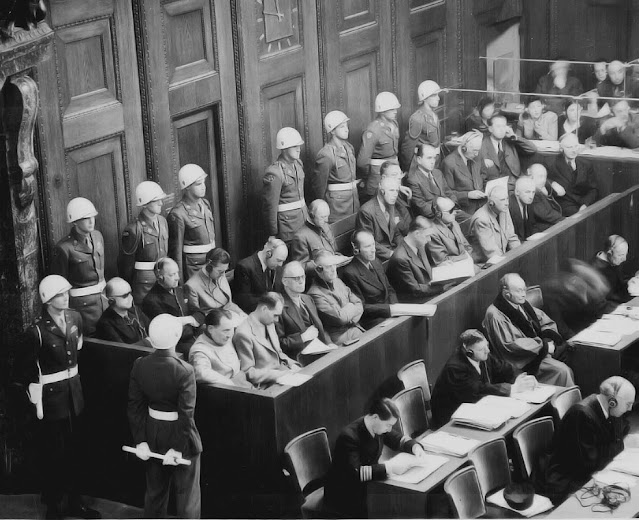On This Date In History
On November 20, 1945, twenty-four high-ranking Nazis go on trial in Nuremberg, Germany, for atrocities committed during World War II.
The Nuremberg trials were conducted by an international tribunal made up of representatives from the United States, the Soviet Union, France and Great Britain. It was the first trial of its kind in history, and the defendants faced charges ranging from crimes against peace, to crimes of war, to crimes against humanity. Lord Justice Geoffrey Lawrence, the British member, presided over the proceedings, which lasted 10 months and consisted of 216 court sessions.
On October 1, 1946, 12 architects of Nazi policy were sentenced to death. Seven others were sentenced to prison terms ranging from 10 years to life, and three were acquitted. Of the original 24 defendants, one, Robert Ley, committed suicide while in prison, and another, Gustav Krupp von Bohlen und Halbach, was deemed mentally and physically incompetent to stand trial. Among those condemned to death by hanging were Joachim von Ribbentrop, Nazi minister of foreign affairs; Hermann Goering, leader of the Gestapo and the Luftwaffe; Alfred Jodl, head of the German armed forces staff; and Wilhelm Frick, minister of the interior.
On October 16, 10 of the architects of Nazi policy were hanged. Goering, who at sentencing was called the “leading war aggressor and creator of the oppressive program against the Jews,” committed suicide by poison on the eve of his scheduled execution. Nazi Party leader Martin Bormann was condemned to death in absentia (but is now believed to have died in May 1945). Trials of lesser German and Axis war criminals continued in Germany into the 1950s and resulted in the conviction of 5,025 other defendants and the execution of 806.
Grand Marshall Karl Doenitz Followed by Albert Speer
On November 20, 1923, the U.S. Patent Office grants Patent No. 1,475,074 to 46-year-old inventor and newspaperman Garrett Morgan for his three-position traffic signal. Though Morgan’s was not the first traffic signal (that one had been installed in London in 1868), it was an important innovation nonetheless: By having a third position besides just “Stop” and “Go,” it regulated crossing vehicles more safely than earlier signals had.
Morgan, the child of two formerly enslaved people, was born in Kentucky in 1877. When he was just 14 years old, he moved north to Ohio to look for a job. First he worked as a handyman in Cincinnati; next he moved to Cleveland, where he worked as a sewing-machine repairman. In 1907, he opened his own repair shop, and in 1909 he added a garment shop to his operation. The business was an enormous success, and by 1920 Morgan had made enough money to start a newspaper, the Cleveland Call, which became one of the most important Black newspapers in the nation.
Morgan was prosperous enough to have a car at a time when the streets were crowded with all manner of vehicles: Bicycles, horse-drawn delivery wagons, streetcars and pedestrians all shared downtown Cleveland’s narrow streets and clogged its intersections. There were manually operated traffic signals where major streets crossed one another, but they were not all that effective: Because they switched back and forth between Stop and Go with no interval in between, drivers had no time to react when the command changed. This led to many collisions between vehicles that both had the right of way when they entered the intersection. As the story goes, when Morgan witnessed an especially spectacular accident at an ostensibly regulated corner, he had an idea: If he designed an automated signal with an interim “warning” position, the ancestor of today’s yellow light, drivers would have time to clear the intersection before crossing traffic entered it.
The signal Morgan patented was a T-shaped pole with three settings. At night, when traffic was light, it could be set at half-mast (like a blinking yellow light today), warning drivers to proceed carefully through the intersection. He sold the rights to his invention to General Electric for $40,000.
Morgan, the child of two formerly enslaved people, was born in Kentucky in 1877. When he was just 14 years old, he moved north to Ohio to look for a job. First he worked as a handyman in Cincinnati; next he moved to Cleveland, where he worked as a sewing-machine repairman. In 1907, he opened his own repair shop, and in 1909 he added a garment shop to his operation. The business was an enormous success, and by 1920 Morgan had made enough money to start a newspaper, the Cleveland Call, which became one of the most important Black newspapers in the nation.
Morgan was prosperous enough to have a car at a time when the streets were crowded with all manner of vehicles: Bicycles, horse-drawn delivery wagons, streetcars and pedestrians all shared downtown Cleveland’s narrow streets and clogged its intersections. There were manually operated traffic signals where major streets crossed one another, but they were not all that effective: Because they switched back and forth between Stop and Go with no interval in between, drivers had no time to react when the command changed. This led to many collisions between vehicles that both had the right of way when they entered the intersection. As the story goes, when Morgan witnessed an especially spectacular accident at an ostensibly regulated corner, he had an idea: If he designed an automated signal with an interim “warning” position, the ancestor of today’s yellow light, drivers would have time to clear the intersection before crossing traffic entered it.
The signal Morgan patented was a T-shaped pole with three settings. At night, when traffic was light, it could be set at half-mast (like a blinking yellow light today), warning drivers to proceed carefully through the intersection. He sold the rights to his invention to General Electric for $40,000.
On November 20, 1820, the American whaler Essex, which hailed from Nantucket, Massachusetts, is attacked by an 80-ton sperm whale 2,000 miles from the western coast of South America.
The 238-ton Essex was in pursuit of sperm whales, specifically the precious oil and bone that could be derived from them, when an enraged bull whale rammed the ship twice and capsized the vessel. The 20 crew members escaped in three open boats, but only five of the men survived the harrowing 83-day journey to the coastal waters of South America, where they were picked up by other ships. Most of the crew resorted to cannibalism during the long journey, and at one point men on one of the long boats drew straws to determine which of the men would be shot in order to provide sustenance for the others. Three other men who had been left on a desolate Pacific island were saved later.
The first capture of a sperm whale by an American vessel was in 1711, marking the birth of an important American industry that commanded a fleet of more than 700 ships by the mid 18th century. Herman Melville’s classic novel Moby-Dick (1851) was inspired in part by the story of the Essex.
The 238-ton Essex was in pursuit of sperm whales, specifically the precious oil and bone that could be derived from them, when an enraged bull whale rammed the ship twice and capsized the vessel. The 20 crew members escaped in three open boats, but only five of the men survived the harrowing 83-day journey to the coastal waters of South America, where they were picked up by other ships. Most of the crew resorted to cannibalism during the long journey, and at one point men on one of the long boats drew straws to determine which of the men would be shot in order to provide sustenance for the others. Three other men who had been left on a desolate Pacific island were saved later.
The first capture of a sperm whale by an American vessel was in 1711, marking the birth of an important American industry that commanded a fleet of more than 700 ships by the mid 18th century. Herman Melville’s classic novel Moby-Dick (1851) was inspired in part by the story of the Essex.




















No comments:
Post a Comment